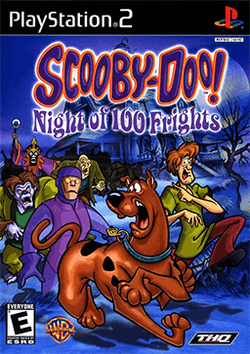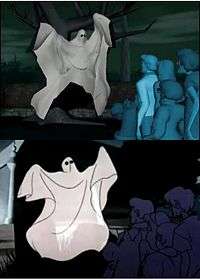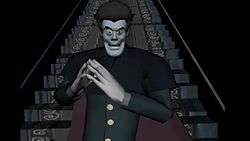Scooby-Doo! Night of 100 Frights
| Scooby-Doo! Night of 100 Frights | |
|---|---|
 North American PS2 cover art | |
| Developer(s) | Heavy Iron Studios |
| Publisher(s) | THQ |
| Distributor(s) | Warner Bros. Interactive Entertainment |
| Composer(s) |
Todd Dennis Tommy Tallarico Howard Uyate |
| Engine | = RenderWare |
| Platform(s) | GameCube, PlayStation 2, Xbox |
| Release date(s) |
PlayStation 2 GameCube Xbox
|
| Genre(s) | Platform |
| Mode(s) | Single-player |
Scooby-Doo! Night of 100 Frights is a third person platform game with action elements that was developed by Heavy Iron Studios and published by THQ for the PlayStation 2, GameCube and Xbox consoles. The game was first released on May 20, 2002 in North America and was released later that year in PAL regions. It is the first Scooby-Doo! video game title to come to sixth generation consoles. The game became a Greatest Hits title in 2003.[1] The game has a follow up titled Scooby-Doo! Mystery Mayhem.
The game puts players in the control of Scooby-Doo in a story that revolves around him searching for the rest of the gang around a haunted mansion after they are kidnapped by an eccentric villain. The game has twelve areas, ranging from graveyards and secret labs to fishing villages and haunted mazes.
The game received mixed reviews from critics, mainly criticizing the game's simplicity, although its massive environments staying true to the Scooby-Doo! universe was praised by critics and fans alike. Fans of the original show loved the game, feeling it was compensation for the N64 game released in 2000. The game also marks the first and only time Don Knotts did voice work for a video game, though he did do previous voice work in the Scooby-Doo universe.[2]
Gameplay
Night of 100 Frights is primarily a third-person game with action elements. The player controls the title character Scooby-Doo. The primary goal of the game is to hunt for the gang after they go missing at the mysterious Mystic Manor. Scooby has several abilities in the game as well as zany inventions he finds on the grounds of the mansion to aid him in his search.

The game's combat system allows the character to run, jump, and perform attacks to fend off enemies that are encountered. Various villains from the original Scooby Doo! show are met throughout the game, as well as other minor villains like bats and crabs. Scooby's health bar goes down when a villain or enemy scares Scooby, and it can only be restored by various food items that can be obtained throughout the game.
Easter Eggs that players can obtain, called "Monster Tokens," are large circles that have a picture of a Scooby-Doo! villain on them; when the player collects the token, the villain will be able to be viewed in a room in Mystic Manor, where trivia about the bad guy is given. Another character in the game known as The Professor has also scattered "inventions" throughout the terrain of the game, that can aid Scooby. Once obtained, the player can go back to a certain area that was not able to be entered before the invention was obtained. There are "warp gates", which are machines that teleport Scooby from check point to check point. The boss fights consist of major Scooby-Doo! villains, such as Redbeard or the Black Knight. Various secret passages which act as short cuts are scattered throughout the game, as well as trap doors. Outside levels also have various obstacles, such as moving platforms and mud-slides.
Also staying true to the Scooby-Doo fashion, Scooby must also collect all of the "Scooby Snack" treats scattered throughout the game in order to open "Snack Gates" that open almost every door. Although it is optional to collect all of the snacks, bonus content is unlocked if the player does so. As the game progresses the Snack Gates demand more Scooby Snacks. The voice acting is complemented by sound effects taken straight from the cartoon, including a laugh track that reacts to Scooby's onscreen actions.[3]
There are also Holiday easter eggs programmed into the game. When the game is played on certain days of the year, special decorations will appear in front of the Manor. For instance, on Christmas, it will be snowing, and on Halloween bats appear above the doors and windows. New Years, Saint Patrick's Day, Valentines Day and Fourth of July are other holidays that have special surprises as well.[4]
Synopsis
Setting
Recreating the classic Scooby-Doo formula, a ghost/monster is terrorizing the locals of a town with Scooby and the gang being called away to solve a mystery. An eccentric villain known as "The Mastermind" kidnaps the gang, and Scooby must venture through graveyards, lighthouses, and secret passages in an effort to solve the mystery and find his friends. The game is mainly set inside a large mansion known as "Mystic Manor". The manor has dozens of rooms and floors, from the secret laboratory in the basement[5] to the haunted attic. The game is set during the late hours of the night. When it is time to venture outside of the Manor, players can explore the vast graveyard section as well as the sea pier section. Each section has its own settings, such as fishing factories[6] and haunted crypts.[7]
Plot
Daphne's friend Holly calls the gang to the mysterious "Mystic Manor" to solve the mystery of her uncle's disappearance. He was a famous inventor who mysteriously vanished before he could reveal his new top-secret invention. Daphne, Fred and Velma agree to help but Scooby-Doo and Shaggy are reluctant. While the rest go into the mysterious Manor, Shaggy falls down a trap door in the floor, leaving Scooby alone outside. Scooby runs into the Manor and finds Holly locked in a hallway, who says The Mastermind took the gang and left her there.
Scooby returns to the courtyard outside the manor, where a mysterious groundskeeper (Don Knotts) gives him a shovel that enables him to dig up a key to enter the nearby fishing village. Upon exploring the village, Scooby finds the professor's many inventions, which are scattered throughout the game.

Scooby returns to the manor and travels through the backyard and then fights his way to the roof top, where he encounters The Mastermind for the first time. He reveals that he is the one who resurrected all of Scooby's old foes, and that he also has Velma locked in a cage near by. The Mastermind then brings the Black Knight Ghost back to fight Scooby and he departs. After Scooby defeats him, he saves Velma. However, after Velma reclaims her glasses, she begins to shriek as she thinks The Creeper is right behind her. A befuddled Scooby stays behind, as there is nobody chasing her.
Scooby then ventures to the Graveyard where he finds more inventions and collects more Monster Tokens. He eventually saves Daphne from the Green Ghost, only to have her and Holly fall through a trap door. Scooby then goes on to the shipwrecks. There, Scooby reaches a pirate ship where he is greeted by Fred and the ghost of Redbeard. Scooby defeats Redbeard, then Fred and Scooby begin a conversation, but are interrupted by Velma, still seeing Creepers. Fred notices that the lenses in her glasses have The Creeper imprinted on them. Curious, Fred and Velma head to the Professor's secret lab. Shaggy then arrives and the two begin to eat, but Shaggy flees after he sees a ghost diver.
Scooby heads for the secret lab, and he discovers the gang waiting for him. They tell him the Mastermind has been using holograms the whole time - thus the recreated monsters and the Creepers on Velma's glasses. Fred devises a plan, but needs Scooby to distract the Mastermind so that it will succeed. Scooby reluctantly agrees and confronts the Mastermind, and after the final boss battle is complete, The Mastermind is then sucked up a strange tube that descends from the ceiling. The gang rushes back to the Manor's parlor.
Back in the Manor's parlor, they unmask the Mastermind. Shaggy initially believes that it's the mysterious groundskeeper but he then appears and rants about how 'it's always the spooky groundskeeper'. The gang then discover that the Mastermind is in fact the Professor himself. Velma, confused, says that the clues do not add up. "If you ask me, someone's playing a nasty trick – a trick of the light!" she announces. She holds her glasses up to a mirror to reveal Holly working the controls of a machine behind a wall. Shaggy is puzzled, as Holly is standing right next to him. He reaches for her, but when his arm goes through her, the gang realizes that Holly is a hologram - the real Holly was the Mastermind all along. Holly was in the Mastermind costume the entire time- she used one of the Professor's inventions to get back to the Mansion from the Secret Lab and put the Professor into the costume. Because Daphne kept Holly "up to date on all of their cases," it was fairly simple to recreate all of their old foes. Holly admits that she wanted Mystery Inc. to come, arrest her uncle as the Mastermind, and leave so she could take the credit for his hologram machine and become rich. Scooby and the gang successfully close another case while Shaggy goes to a table full of food only to find out that it is a hologram controlled by Scooby.
Reception
| Reception | ||||||||||||||||||||||||||||||||||||
|---|---|---|---|---|---|---|---|---|---|---|---|---|---|---|---|---|---|---|---|---|---|---|---|---|---|---|---|---|---|---|---|---|---|---|---|---|
| ||||||||||||||||||||||||||||||||||||
| ||||||||||||||||||||||||||||||||||||
Night of 100 Frights was met with mixed to average reviews from critics. GameRankings and Metacritic gave it a score of 69.54% and 69 out of 100 for the PlayStation 2 version;[10][12] 68.14% and 68 out of 100 for the GameCube version;[11][13] and 70.83% and 66 out of 100 for the Xbox version.[9][14]
Many critics disliked the game's simplicity, while praising the voice acting and the fact that it stays true to the Scooby-Doo! universe, featuring music and villains from the original episodes. However, many critics were not happy with the camera angles, calling them "awkward."
References
- ↑
- ↑
- ↑
- ↑
- ↑
- ↑
- ↑
- ↑
- 1 2 "Scooby-Doo! Night of 100 Frights for Xbox". GameRankings. Retrieved June 10, 2014.
- 1 2 "Scooby-Doo! Night of 100 Frights for PlayStation 2". GameRankings. Retrieved June 10, 2014.
- 1 2 "Scooby-Doo! Night of 100 Frights for GameCube". GameRankings. Retrieved June 10, 2014.
- 1 2 "Scooby-Doo! Night of 100 Frights for PlayStation 2 Reviews". Metacritic. Retrieved June 10, 2014.
- 1 2 "Scooby-Doo! Night of 100 Frights for GameCube Reviews". Metacritic. Retrieved June 10, 2014.
- 1 2 "Scooby-Doo! Night of 100 Frights for Xbox Reviews". Metacritic. Retrieved June 10, 2014.
- ↑ Marriott, Scott Alan. "Scooby-Doo! Night of 100 Frights (PS2) - Review". Allgame. Retrieved June 10, 2014.
- ↑ EGM staff (July 2002). "Scooby-Doo! Night of 100 Frights (PS2)". Electronic Gaming Monthly (157): 120.
- ↑ Helgeson, Matt (August 2002). "Scooby-Doo 2: Night of 100 Frights [sic] (PS2)". Game Informer (112): 79. Archived from the original on November 14, 2004. Retrieved June 10, 2014.
- ↑ Provo, Frank (June 20, 2002). "Scooby-Doo! Night of 100 Frights (PS2)". GameSpot. Retrieved June 10, 2014.
- ↑ Provo, Frank (September 25, 2002). "Scooby-Doo! Night of 100 Frights Review (GC)". GameSpot. Retrieved June 10, 2014.
- ↑ Provo, Frank (September 5, 2003). "Scooby-Doo! Night of 100 Frights (Xbox)". GameSpot. Retrieved June 10, 2014.
- ↑ Abarcar, Gabe "The Prof" (June 15, 2002). "Scooby-Doo! Night of 100 Frights (PS2)". GameSpy. Archived from the original on January 7, 2006. Retrieved June 10, 2014.
- ↑ Murphy, Kevin (October 22, 2002). "GameSpy: Scooby-Doo Night of 100 Frights (GCN)". GameSpy. Archived from the original on September 5, 2005. Retrieved June 10, 2014.
- ↑ Hopper, Steven (October 8, 2002). "Scooby-Doo! Nights of 100 Frights![sic] - GC - Review". GameZone. Archived from the original on October 16, 2008. Retrieved June 10, 2014.
- ↑ Hopper, Steven (September 13, 2003). "Scooby-Doo! Nights of 100 Frights! [sic] - XB - Review". GameZone. Archived from the original on January 25, 2009. Retrieved June 10, 2014.
- ↑ Tha Wiz (June 10, 2002). "Scooby-Doo! Night of 100 Frights - PS2 - Review". GameZone. Archived from the original on October 9, 2008. Retrieved June 10, 2014.
- ↑ Perry, Douglass C. (June 5, 2002). "Scooby-Doo: Night of 100 Frights (PS2)". IGN. Retrieved June 10, 2014.
- ↑ Perry, Douglass C. (October 14, 2003). "Scooby-Doo: Night of 100 Frights Review (Xbox)". IGN. Retrieved June 10, 2014.
- ↑ Perry, Douglass C. (September 18, 2002). "Scooby-Doo! Night of 100 Frights! (GCN)". IGN. Retrieved June 10, 2014.
- ↑ "Scooby-Doo! Night of 100 Frights". Nintendo Power. 162: 224. November 2002.
- ↑ Kosmina, Ben (October 22, 2002). "Scooby-Doo! Night of 100 Frights". Nintendo World Report. Retrieved June 10, 2014.
- ↑ "Scooby-Doo! Night of 100 Frights". Official U.S. PlayStation Magazine: 101. July 2002.
- ↑ "Scooby-Doo! Night of 100 Frights". Official Xbox Magazine: 130. November 2003.
- ↑ Boyce, Ryan (May 1, 2002). "Scooby-Doo: Night of 100 Frights (PS2)". Maxim. Retrieved June 10, 2014.
- ↑